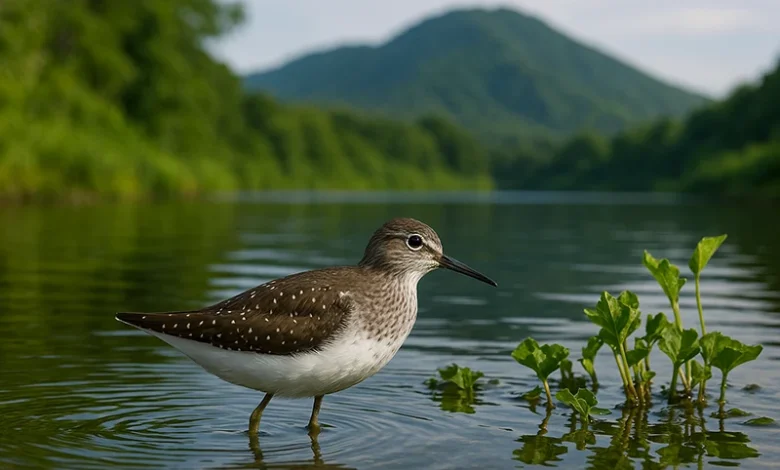Solitary Sandpiper

The Solitary Sandpiper (Tringa solitaria) is a graceful, medium-sized wader that visits Dominica as a passage migrant, typically observed during spring and autumn migrations. True to its name, it is almost always seen alone, frequenting freshwater ponds, riverbanks, marshy fields, and temporary inland wetlands. While less common than the Spotted Sandpiper, it is a consistent visitor for those who know where to look—especially after rains create new feeding areas.
Appearance and Identification
Measuring about 20–23 cm (8–9 inches) long, the Solitary Sandpiper is notable for its dark greenish-brown back spotted with white, white underparts, and a distinctive white eye ring. It has a slim profile, straight dark bill, and olive-green legs. In flight, it lacks the white rump seen in many other Tringa species, helping distinguish it from close relatives.
Habitat and Sightings in Dominica
Though not a resident species, the Solitary Sandpiper can be found in inland freshwater habitats, especially in the following areas:
- Layou River floodplain and shallow wetlands – Common stopover for migrating birds.
- Canefield and Mahaut lowland fields – Frequently seen in flooded grasslands or roadside ponds.
- Freshwater Lake margins (during wet years) – May pause briefly in backwater pools.
- Woodford Hill and Londonderry agricultural zones – Seasonal foraging grounds after rains.
It avoids open shorelines preferred by other sandpipers and instead favors quiet, vegetated edges of inland water bodies.
Behavior and Birdwatching Tips
Unlike flocking sandpipers, this species is nearly always seen alone, hence its name. It feeds on aquatic insects, small crustaceans, worms, and invertebrates, probing mud with its slender bill or picking prey from shallow water.
Tips to spot the Solitary Sandpiper:
- Look near still, freshwater pools with good surrounding vegetation.
- Visit during migration windows: March–May and August–October.
- Observe from a distance—this bird flushes easily and flies in a zigzag pattern.
- Use binoculars to identify the white eye ring and lack of wing stripes or white rump.
Seasonal Presence and Significance
The Solitary Sandpiper is a non-breeding transient in Dominica, but sightings are regular during migration seasons, especially in wetter years. Its presence highlights the importance of maintaining freshwater wetlands and temporary pools, which serve as critical rest stops for long-distance migrants crossing the Caribbean.
The Solitary Sandpiper is a quiet visitor that brings elegance to Dominica’s lesser-known interior wetlands—rewarding the observant birder with its solitary beauty and secretive charm.




